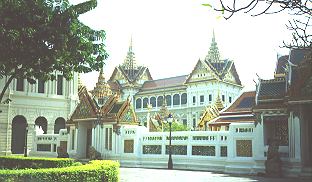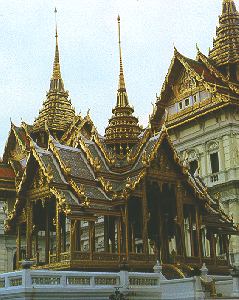|
The Phra-Thinang Chakri Maha Prasat Group
|

KING BUDDHA YOT FA CHULALOK [ Rama I ] 1782 - 1809
An oil portrait of King Rama I painted in 1882 by a European artist,
graces a gallery in the Chakri Throne Hall, Grand Palace

|
The Phra-Thinang Chakri Maha Prasat Group
This group is located between the Phra Maha Monthian and Phra-Thinang Dusit Maha Prasat.
It was built by King Chulalongkorn. In the beginning there were 11 buildings but now only three remain.
The eleven buildings were not constructed at the same time. First came the palace were King Chulalongkorn
was born and lived with his mother and younger brothers. After ascending the throne, he moved to the Phra Maha Monthian
and he decided to replace his living quarters here. Construction began in 1869 and was completed in A.D. 1873.
|
The first buildings consisted of four units in European style. They are;
1.
2.
3.
4.
|
Phra-Thinang Mulasathan Borom-at which is connected to the main hall of Chakri Maha Prasat to the east.
Phra-Thinang Sommottithewarat Upbat, which is joined to the western side of the main hall of Chakri Maha Prasat.
Phra-Thinang Damrongsawat Ananyawong, which is attached to the western side of Phra-Thinang Sommottithewarat Upbat.
Phra-Thinang Niphatthapong Thaworawichit, which is next to Phra-Thinang Mulasathan Borom-at.
|
|
This group of Palaces later fell into decay beyond repair. The present King had them pulled down and rebuilt only two of them.
They are Phra-Thinang Mulasathan Borom-at and Phra-Thinang Sommottithewarat Upbat.
Phra-Thinang Mulasathan Borom-at
This two-storey building stands on the site of Phra-Thinang Mulasathan Borom-at and Niphatthapong Thaworawichit. The length of this
new building is equal to the two former edifices added together. It is used as a banquet hall.
Phra-Thinang Sommottithewarat Upbat
This two-storey building stands on the site of Sommottithewarat Upbat and Damrongsawat Ananyawong. It is used to serve tea.
After having built the four palace buildings as mentioned, King Chulalongkorn built another group to the south of the first in 1870 and
completed them in three years. They were six European style buildings;
|
The first buildings consisted of four units in European style. They are;
1.
2.
3.
4.
5.
6.
|
Phra-Thinang Boromratchasathit Maholan, which was situated to the rear of Chakri Maha Prasat.
Phra-Thinang Amonphimanmani, which was built next to the rear verandah of the first.
Phra-Thinang Sutthasi-aphirom, which was to the east of the second.
Phra-Thinang Bannakhomsorani, which was to the west of the second.
Phra-Thinang Ratchapridiwarothai, which adjoined the first in the north on the western side.
Phra-Thinang Thepdanainanthayakon, which was built adjoining the first one in the north on the eastern side.
|
|
All these buildings were pulled down to make way for the construction of the new Boromratchasathit Moholan.
|

Phra-Thinang Chakri Maha Prasat
Phra-Thinang Chakri Maha Prasat
This was constructed during the reign of King Chulalongkorn to commemorate the centenary of the Chakri Dynasty.
It was designed by a British architect, in the European style with a roof in pure Thai style, thus blending East and West.
Construction lasted for six years from 1876 to 1882. The roof has three spires of seven-tiered Mondop style. At the four
corner of the base of the spires there used to be moulding of Garudas holding Nagas
as decorative supports, but during renovation in King Rama VII's reign they were replaced by swan-shaped brackets. The roof is in two-tiers and covered with coloured glazed tiles.
On the top floor of the central mansion the royal ashes are kept and the king gives public audience from a front projection there of. The second floor serves as an audience
hall where portraits of the present King and Queen are displayed. On the ground floor is the office of the royal guards.
In the eastern mansion, religious objects are kept on the top floor. The middle floor aerves as a reception hall for royal-guests. On the wall the family portrait of King Chulalongkorn,
his Queen Sri Bacharindra and their five sons is hung. The lowest floor serves as a guest's waiting room.
In the western mansion, on the top floor are kept the ashes of queens and high ranking princes and princesses. The middle floor serve as guests' chamber where on the wall are
hung the portraits of King Rama VII and Her Majesty Queen Rambhai Barni. The lowest floor serves as library.
A gallery joins the central mansion to the eastern mansion. The middle floor is devided lengthwise into two parts. The inner part is a receotion room where the portraits of the Kings of the Chakri Dynasty
from King Rama I to King Rama VII are hung. The outer part is a verandah which connects the throne hall to the reception hall.
Another gallery joins the central mansion to the western one. The middle floor is an open hall for receiving guests. On the wall there are portraits of the Queens of King Rama IV, Rama V and Rama VII.
The ground floor is also an open hall.
In the rear centre of Chakri Maha Prasat is the Chakri Throne Room where the King receives ambassadors on the occasion of the presentation of their credentials. At the end of the room stands the
throne called Phuttanthom throne, made of wood covered with sillver and gold foil. A nine tiered white umbrella made for King Chulalongkorn stands over this throne. The emblem of the Chakri Dynasty is
depicted on the wall behind the throne. The other walls are decorated with four canvasses depicting diplomatic receptions of the past. One on the right as one enters the room depicts the reception by
Queen Victoria of King Mongkut's ambassador in London, further on is Louis XIV's reception of the mission sent by King Narai the Great of Ayutthaya in the Gallerie des Glaces in the palace of Versailles;
the third, on the other side of the room, King Mongkut's reception of the French Envoy, and the fouth, the reception at Fontainebleau by the Emperor Napoleon III of another Siamese Mission. The crystal
decorations of the hall are mostly presents from foreign monarches of King Chulalongkorn.
From this rear throne hall there are doors leading to Phra-Thinang Mulasathan Borom-at and Sommottithewarat Upbat. It is joined with Boromratchasathit Maholan where the king gave audience to
princesses and female courtiers in the days when ladies were not allowed to mix with gentlemen.

A corner of Aphonphimok Pavilion. Chakri Maha Prasat can be seen in the background
|



